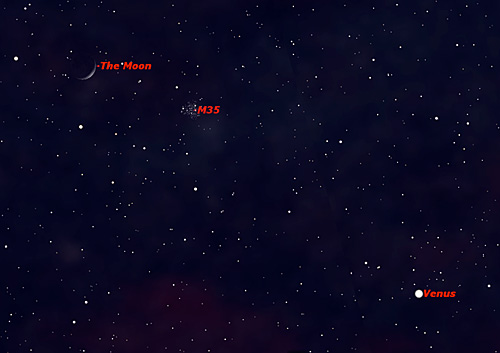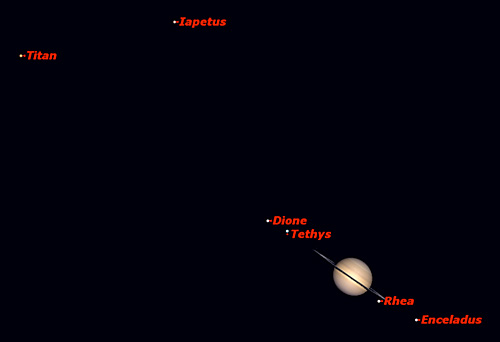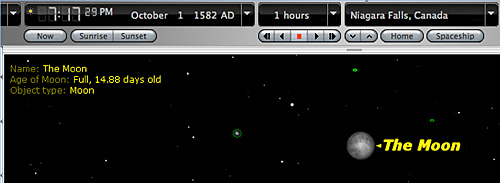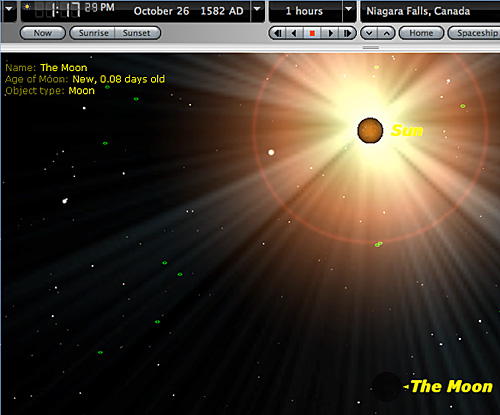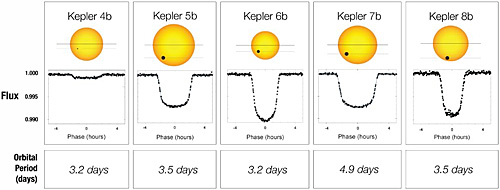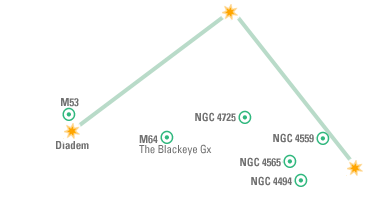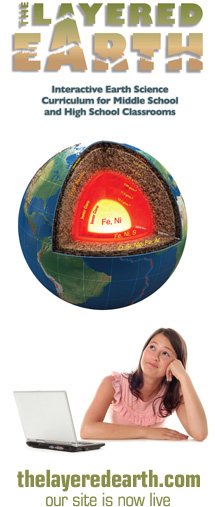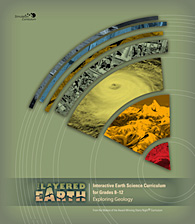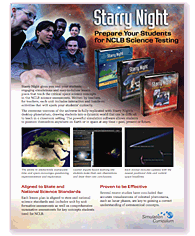 |
||||||||||||||||||||||||||||||||||||||||||||||||||||||||||||||||||||||||||||||||||||||||||||||||||||||||||||||
For education orders please call 1-877-290-8256. Welcome again to our monthly newsletter with features on exciting celestial events, product reviews, tips & tricks, and a monthly sky calendar. We hope you enjoy it!
Simply capture Starry Night in action, write a short description, tell us which version of Starry Night you're using and what you love about it. Send your screenshot to photo@starrynight.com. If we use any of your images in our Store, we'll send you your choice of one of our award-winning Astronomy DVDs or this beautiful Astronomy Poster Set. Images must be in JPG, GIF, or TIFF format (not zipped, please), 700px or smaller and 2MB or less.
Important note: In submitting your image or images to Simulation Curriculum®, you waive copyright and agree to allow us to publish them in all media—on the Web or otherwise—now and in the future.
Many amateur astronomers are actively involved in outreach, and often are called upon to conduct star parties for schools and the general public. Starry Night can be a very useful tool in organizing such events. Date With Starry Night you can quickly and easily check out possible dates and alternates. Because star parties are so dependent on the weather, it's good to have a “rain date” in mind. As discussed below, the Moon is usually the centerpiece of any star party, so keep that in mind when choosing a date. The best time to observe the rugged surface of the Moon is around First Quarter. This is because the terminator, the line between sunlight and shadow, is well placed around first quarter. It's also well placed at third quarter, but the Moon is then in the morning sky. You want to stay away from the days immediately before Full Moon, because the Moon will be flooding the sky with light, making any deep sky observing nearly impossible. The days between New Moon and First Quarter are particularly good, because the Moon sets fairly early. You might also consider a few days after Full Moon. The Moon will still be bright, but it won't rise until late in the evening, providing a good finale to the party. Starting Time As John Percy likes to say, “The stars come out at night, the students don't.” The perpetual problem with school star parties is that it's either too cold, or, if it's warmer, it doesn't get dark until past most kids' bedtimes. So it's important to start the star party early enough to get good attendance yet late enough that some deep sky objects will be visible. Starry Night is an excellent tool for determining when a star party should begin, as it accurately depicts the changing sky of twilight. If the Moon is around First Quarter, it can provide a target while the sky gets darker. Next you can view planets, double stars, and, finally deep sky objects. Which Telescope? Just about any telescope will do but, if you have some choice, here are some things to consider.
Which Objects? You should give serious thought as to what objects to choose as targets. Objects which are absolutely fascinating to serious amateur astronomers are often total bores to an uninformed observers. Stick to objects which you can locate quickly and easily, as it can be very frustrating to hold up a long line of viewers while you reacquire an object the last viewer knocked out of the field. The Moon is by far the most popular target at star parties with both kids and adults. I find it useful to show it at both low and high magnification. Low magnification gives the big picture, while high magnification shows off the wealth of detail visible on the Moon. I usually prepare myself by choosing an area of the Moon's surface which will be well placed, and preparing some notes on it from Starry Night. The Apollo landing sites are particularly interesting, and can open up all kinds of interesting discussions. Planets are a mixed bag. Many people are disappointed by how small the planets appear in most amateur telescopes. Mars is almost always a big disappointment unless it's close to opposition and the telescope is large and of high quality. Jupiter and its moons always go over well, especially if there is a shadow of one of the moons cast upon Jupiter. Use Starry Night to identify the moons by name ahead of time. Most people now recognize at least some of the moons' names because of the many images on the internet. Untrained eyes are not likely to see more than a band or two on Jupiter's disk. Saturn is also always a winner, though you shouldn't be afraid to put on some magnification; it takes at least 100x to see the rings well. Use Starry Night to identify the moons ahead of time; Titan is visible in any telescope, and four or five others may also be visible in larger scopes.
Double stars, although not too popular with amateur astronomers, have proven to be very popular at any star parties where I've shown them. Strong color contrasts like Albireo go over well, and many people are fascinated by Epsilon Lyrae, the Double Double. People see only the two main components at first glance, but can be talked along into spotting the two close binaries, if the scope has sufficient resolution and magnification. I usually ask people to describe the orientation of the two binaries, which is a good indicator that they've actually split them. Open star clusters are always winners! Any of the bright well known clusters will do, but my favorite for school star parties is the “E.T.” Cluster, NGC 457 in Cassiopeia. Use low power and a wide-field eyepiece. Globular clusters are best with larger telescopes which resolve them into stars and can tolerate a fairly high magnification. Stick to the bright easy ones like Messier 3, 4, 5, and 13. Planetary nebulae are particularly good, even in urban locations. Again, stick to the brighter examples: the Ring, the Dumbbell, and the Eskimo. Be sure to put on enough magnification to show their nebular nature. I particularly like the Ring because it is so easy to find, even before the sky is fully dark. Be prepared that some people simply won't see it...it's not easy for an inexperienced observer. Be patient and take the time to describe exactly what they're looking for. Diffuse nebulae are challenging objects for public star parties. Even the really bright ones, such as Orion and the Swan, may be totally invisible to many people. I once heard the story of someone trying to show a newbie the Orion Nebula. No luck. Finally the newbie said, “Maybe I'd be able to see it if that little cloud would get out of the way!” I left galaxies for last because they really are very frustrating objects for beginners. The Andromeda Galaxy is too big and overflows the field of view of most telescopes. The rest are too small and/or faint smudges. I really don't recommend showing galaxies at public star parties unless you are blessed with a really dark sky. Always finish up with a big bright object, like a planet or a double star, and leave them asking for more! Geoff Gaherty
The average time between full moons is about 29.5 days. This is known as the synodic period of the Moon or a lunation. It stands to reason then, that half a lunation -- the time from Full Moon to New Moon -- should be a bit less than 15 days. Well, consider the Full Moon of October 1, 1582.
We would expect the next New Moon to occur around October 16, 1582. Not so! It doesn't occur until October the 26th!
What's going on? By now, you've probably guessed that there is something special about October 1582. Indeed! In February of that year, Pope Gregory XIII decided it was time to reform the calendar. The old Julian calendar, which had been in use for over 1500 years, was getting out of line. The beginning of spring had slipped back to March 11 and this affected the date of Easter which is of great importance to the Catholic Church. Thus by papal decree, October 4, 1582 was followed by October 15, 1582. And Starry Night, like most of Europe, has accepted this change by deleting October 5 to 14. You can see this for yourself by loading the following file Oct1582.snf and changing the date by one day. So our mystery is solved. The Gregorian October 26, 1582 = the Julian October 16, 1582. The Moon is well-behaved after all! Herb Koller
Now With 50% More Factoids The Kepler probe is in an Earth-trailing heliocentric orbit, meaning that it follows the Earth in its orbit around the Sun. This prevents the Earth from getting in the way of Kepler's target field, a patch of sky between Cygnus and Lyra. To date, Kepler has discovered five extrasolar planets, proving that it can do the job it was designed for, although so far none of these are Earthlike planets. They're all bigger than Earth. The smallest has a mass that is about 7% of Jupiter's. (Earth, by comparison, is less than half a percent of Jupiter's mass.)
Transit Light Curves [Source NASA] They're also all in smaller orbits. A planet in an Earthlike orbit around a Sun-like star would take about the same amount of time to orbit its star as Earth does. To detect and confirm any extrasolar planet's existence by the transit method requires three transits: one to detect, one to confirm that it's something periodic, and one to confirm the length of the period. The discovery of a planet in an Earthlike orbit, or one that takes about one Earth year to complete an orbit, won't be announced until at least two years after the first detection!
Planet Sizes [Source NASA] Weirdest planet discovered: Kepler-7b has half the mass of Jupiter despite being half again as wide. Its density is a bit more than a tenth of the density of water at sea level on Earth. Just like Saturn, if you had a bathtub big enough for this planet, it would float. But unlike Saturn, these so-called 'hot Jupiters' are puffed up because they're hot. If they were farther from their suns they would be cooler and smaller. The heat makes the gas expand and you end up with a planet that has so little density that it could float in water – but then again, any water in the vicinity would be instantly steamed off. Stay tuned to Kepler's discoveries: Brenda Shaw
Lunar Libration Open the “Lunar Libration Monthly” file and press the Run Time Forward button to illustrate the monthly libration of the Moon. Although the Moon is in a 1:1 spin-orbit lock with Earth, and rotates at a constant rate, its orbit is eccentric — and therefore the Moon revolves about the Earth at an inconstant angular rate. The resulting east-west "rocking" of the Moon is called longitudinal libration. The north-south "rocking" is caused by the fact that the Moon's orbit is tipped slightly more than 5 degrees to the ecliptic, so we are able to see varying views of the polar regions through the month. These librations thus allow us to see about 59% of the actual surface area of the Moon in a month. Pedro Braganca
At this time of year, Coma Berenices hangs high overhead, very well-placed for observation. Berenice was an Egyptian queen, the wife of King Ptolemy III Euergestes. When her husband went off to war, to ensure his safe return, she promised her hair to Aphrodite. The King did indeed return and Berenice gave up her hair, a tuft of which became this constellation. Diadem is a binary star about 47 lightyears from us. It's two suns cannot be split in telescopes but, just a little to the north, M53 hangs in space at a much greater distance: 60,000 lightyears. M53 is a halo cluster, filled with dozens of Mag 13 stars. M64, The Blackeye Galaxy, gets its famous name from the dark dust lane that cuts through the galaxy's core. With averted vision, you'll just be able to make out the lane. Overall, the galaxy is bright enough to be visible in binoculars. NGC 4725 is a large bright spiral galaxy which has been warped by its interactions with close-by NGC 4747. This patch of sky also contains the North Galactic Pole. NGC 4559, a faint spiral galaxy, is inclined 20° from edge-on. The larger your scope the better the view. NGC 4565 is inclined only 4° from edge-on and is breath-taking. Both galaxies belong to the Virgo Cluster. NGC 4494 is an elliptical galaxy whose core rotates very rapidly—and in the opposite direction to the stars in the outer disk! Sean O'Dwyer
|
MAY 2010
|
|||||||||||||||||||||||||||||||||||||||||||||||||||||||||||||||||||||||||||||||||||||||||||||||||||||||||||||
 |
||||||||||||||||||||||||||||||||||||||||||||||||||||||||||||||||||||||||||||||||||||||||||||||||||||||||||||||
|
||||||||||||||||||||||||||||||||||||||||||||||||||||||||||||||||||||||||||||||||||||||||||||||||||||||||||||||
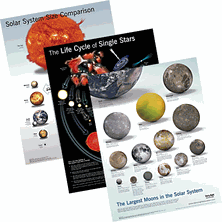 We've launched our new, streamlined
We've launched our new, streamlined 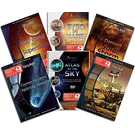 Don't have the latest version? Know someone who isn't running Starry Night yet? To celebrate our launch, we're also offering a 20% discount on any item in the store! Simply choose your software (upgrade OR new) and enter coupon code 'Clear Skies' in the shopping cart.
Don't have the latest version? Know someone who isn't running Starry Night yet? To celebrate our launch, we're also offering a 20% discount on any item in the store! Simply choose your software (upgrade OR new) and enter coupon code 'Clear Skies' in the shopping cart.